Papers by Tjamke Snijders
BMGN - The Low Countries History Review, 2024
High medieval booklists are routinely interpreted as administrative sources that existed to inven... more High medieval booklists are routinely interpreted as administrative sources that existed to inventory book collections, somewhat similar to present-day library catalogues. Historians, however, have found them curiously unreliable and impractical. A case study of the Benedictine monastery of St. Laurent in Liège suggests a different approach to booklists. The thirteenth-century St. Laurent booklist was used, I argue in this article, to position the library as a centre of trinitarian expertise, fundamentally orthodox, and highly respectable. In order to do so, the booklist had to strategically neglect several books that might detract from the image of a perfect library. Booklists such as those from St. Laurent were, therefore, complex mixtures of the administrative with the political, and should be studied as such.

KU Leuven Libraries Open access Spectral data of historical paper, parchment/vellum, leather, inks and pigments (Version 1.0)
It is the goal of this project, A. to produce a sufficient number of different spectral measureme... more It is the goal of this project, A. to produce a sufficient number of different spectral measurements on a wide variety of historical paper, parchment/vellum, leather, inks, and pigments media, to fuel the above-sketched procedure. To accomplish this, objects from KU Leuven Libraries Special Collections have been used. In addition, a number of contemporary pieces of parchment and vellum were also selected for the exercise. B. to document extensively which materials have been included in the exercise, i.e. media type, date of media, condition of media, and exact regions of interest (ROI) with specific materials on the media. C. to use the results to develop a color calibration target for the digitisation with still images of library and archive documents (the same procedure can be used to create specific targets for faithful reproduction on other fields such as archaeology pottery studies). D. to publish the acquired spectral data and produced documentation as open data.
For a visualisation and brief comparison of the spectral data, see https://www.youtube.com/watch?v=kpD_xtnJdx4
The Black Cistercians: The Reactions of Black Monks to Bernard of Clairvaux and the Challenges of Increased Competition
The Catholic Historical Review, 2019
In the twelfth and thirteenth centuries, Black Monks possessed more works by Bernard of Clairvaux... more In the twelfth and thirteenth centuries, Black Monks possessed more works by Bernard of Clairvaux than the Cistercians themselves. This situation has historically been taken as evidence for the Black Monks' great admiration for Bernard's spiritual message. Based on a comparison of booklists from Southern Germany, England, and the Southern Low Countries, this article argues that the reality was more acomplicated. In the Southern Low Countries, the Black Monks studied Bernard's works and for a while attempted to counter the pull of Clairvaux by becoming more like the Cistercians themselves. In England and Southern Germany, where Bernard posed less of a threat, the Black Monks were significantly less interested in his writings.

Behind the Scenes: Establishing a Scriptorium in the Eleventh-Century Monastery of Saint-Sépulcre, Cambrai
Manuscripta: A Journal for Manuscript Research, 2019
Little work has thoroughly examined the problems that faced startup scriptoria in the High Middle... more Little work has thoroughly examined the problems that faced startup scriptoria in the High Middle Ages. This article examines the scriptorium of Saint-Sépulcre in the first decades after this Cambrai monastery was founded in 1064. A man who called himself Fulbertus Peccator (“Fulbert the Sinner”) led the scriptorium during those years. He wrote at least 1,100 folios of foundational texts, but could not single-handedly fill the entire library. Fulbert therefore encouraged most, if not all, of Saint-Sépulcre’s monks to participate in the production of hagiographical manuscripts, even if those monks were wholly unqualified. This article demonstrates that Fulbert’s unusual decision not only helped fill the library with the hagiographical texts it needed, but also changed the significance of the resulting manuscripts for the monastic community. Much more than the sum of their parts, these manuscripts were created as objects that represented the communal spirit and the vibrancy of the newly founded monastery of Saint-Sépulcre.
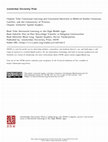
Horizontal Learning in the High Middle Ages: Peer-to-Peer Knowledge Transfer in Religious Communities, 2019
This contribution sketches a conceptual history of the ideational component
of community in the f... more This contribution sketches a conceptual history of the ideational component
of community in the field of medieval studies. It shows that medieval
scholars have usually proceeded from a ‘strong’ definition of communities,
emphasized geographical boundaries, posited the importance of
consensus, and focused on a common denominator that could be used
to characterize the community. The traditional approach to community
can be contrasted with the concept of a ‘Community of Practice’, which
defines a community as a practice-based social group whose identity is
based on shared performances of a repertoire that is in constant flux. An
implementation of this approach can provide medievalists with the tools
to re-interpret medieval communal identities as multiform and caught
up in a continual process of renegotiation; and what this means for the
way we conceptualize communal learning.
Post-factual politics in de elfde eeuw: Het gebruik van Romeinse legendes in de identiteitspolitiek van Angelsaksische koninginnen
Queeste, 2017

Reconsidering Benedictine Manuscript Production in the Thirteenth Century: The Case of Stavelot-Malmedy
The libraries of Benedictine abbeys are one of the key sources for the intellectual history of el... more The libraries of Benedictine abbeys are one of the key sources for the intellectual history of eleventh- and twelfth-century Western:Europel. Not only did their owners enjoy a virtual monopoly on the written word that made them the prime commentators on the developments of their age, they also undertook to preserve and classify their knowledge. The resulting libraries could range from a small stack of manuscripts to collections of volumes that ran in the hundreds, both reflecting and shaping the economic, social, political and religious environment that confronted their creators and administrators2. As the years unfolded, books were added to the library or given away, moved to other locations, rewritten, rebound, stolen or destroyed. As such, the composition and development of a monastic library constitutes a material commentary that can equal the power of expression of the manuscript texts themselves.
Rewriting Chronicles in an Urban Environment: The Middle Dutch “Excellent Chronicle of Flanders”-Tradition
Rewriting Chronicles in an Urban Environment: The Middle Dutch “Excellent Chronicle of Flanders”-... more Rewriting Chronicles in an Urban Environment: The Middle Dutch “Excellent Chronicle of Flanders”-Tradition
(with Tjamke Snijders) Echoes of Benedictine Reform in an Eleventh-Century Booklist from Marchiennes

(with Steven Vanderputten), 'From Scandal to Monastic Penance: A Reconciliatory Manuscript from the Early Twelfth-Century Abbey of St.-Laurent in Liège' (Church History)
Church History: Studies in Christianity and Culture 82:3, pp. 523-553, Sep 2013
An important element of monastic penance and conflict resolution was its repetitive, almost cycli... more An important element of monastic penance and conflict resolution was its repetitive, almost cyclical nature. The manuscripts that were used during these performances often proceed implicitly, which makes them difficult to contextualize and understand. This article considers a possible example of such "hidden" reconciliatory discourse in a manuscript that was produced for the congregation of St. Laurent in Liège around the turn of the eleventh century: Brussels, Royal Library 9361-67. It examines the sin of pride in monastic dignitaries, discusses the best way to atone for it, and provides tools for the penitent to start living a more virtuous life in the future. The surviving evidence suggests that this manuscript was produced in reaction to the deeds of abbot Berenger, whose actions in 1095 were considered scandalous by contemporaries because he had led his monks into confusion and sin. The article shows how the combination of texts in this manuscript takes on a different meaning because of these politically charged circumstances, and argues that the St. Laurent manuscript was a discreet but methodical way to end the resulting estrangement between Berenger and his monks. In this interpretation, Brussels RL 9361-67 is a rare and highly relevant testimony to the ways in which monks in the early twelfth century dealt with psychological and social tensions in the wake of an intra-group conflict.

BMGN - Low Countries History Review, 2013
The functionality of a hagiographical text in the High Middle Ages depended on the codex in which... more The functionality of a hagiographical text in the High Middle Ages depended on the codex in which it was incorporated. As a result, a manuscript perspective is indispensable to assess the communicative function of a medieval saint’s life. This article analyses five codices concerning Saint Remaclus from the monastery of Stavelot-Malmedy as a way to study the changing strategies of hagiographic propaganda. The community of Stavelot-Malmedy experienced a growing need to increase the propagandist user-friendliness of their manuscripts between the tenth and the thirteenth century. A tenth-century manuscript consisted of a jumble of texts about Remaclus and Stavelot-Malmedy intended for a very broad audience. A second generation of codices consisted of a collection of texts better tailored to a more narrowly defined audience, while the third generation focuses almost exclusively on very specific, contemporary problems. An analysis of these manuscripts shows that these ‘generations’ or general types of manuscripts were representative of the Benedictine Southern Low Countries, and that an abbey’s choice for a specific type of manuscript can often be linked to its institutional position.
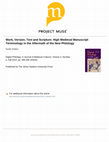
Digital Philology: A Journal of Medieval Cultures
This article reviews the terminological framework to describe manuscripts. The Lachmannian termin... more This article reviews the terminological framework to describe manuscripts. The Lachmannian terminology allows scholars to classify manuscripts as versions or variants of a work on a purely textual basis, but lacks a rigid designator to indicate a (part of a) manuscript as a unit of text and material considerations. Conversely, scholars who adopt Dagenais’ solution to renounce the work and concentrate on the material scriptum gain a rigid designator, but threaten to lose the ability to classify manuscripts at all. Proceeding from a case study, the article argues that the twelfth-century view of a work’s ontological status enables medievalists to keep classifying their scripta on both textual and material grounds. It explores the possibility of using Dagenais’ scriptum as the foundation for a Neo-Lachmannian terminological framework that allows scholars to study manuscript variance and materiality without losing the ability to classify them.
'Rewriting Hagiography in High Medieval Monasteries: Towards a Quantitative Approach'
Y. Desplenter, R. Gabriël and J. Oosterman (ed.), Between Stability and Transformation: Textual Traditions in the Medieval Netherlands
with Steven Vanderputten, ‘Stability and Transformation in the Cult of an Early Medieval Saint: The Case of Bishop Folcuin of Thérouanne’ (Studi Medievali)
Studi Medievali

Revue d’Histoire Ecclésiastique 107:3-4 (2012), 2012
In 1024, the nuns of the Flemish monastery of Marchiennes were expelled from their nunnery to be ... more In 1024, the nuns of the Flemish monastery of Marchiennes were expelled from their nunnery to be replaced by monks. Soon after this reform, the monks created a manuscript (Douai Bibliothèque Municipale 849) that contained all known stories about the monastery’s patron saints. It is tempting to construe this codex as the creation of ‘a central text’ by the community of Marchiennes, referring to Brian Stock’s acclaimed concept of a ‘textual community’. However, a closer look at the manuscript reveals that it did not lay the foundations for a unified interpretation of Marchiennes’ history, but emphasized diversity and consciously targeted various subgroups within the monastery. Douai BM 849 testifies that although it was vital for a newly reformed community to develop a basis of shared stories, interests and values, this did not necessarily require the creation of one shared, monolithic interpretation of its history.
Steven Vanderputten (ed.), Understanding Monastic Practices of Oral Communication (Western Europe, Eleventh-Thirteenth Centuries), 2011

Jaarboek voor Middeleeuwse Geschiedenis 13 (2010) 6-32., 2010
When Heribrand became abbot of Saint-Ghislain (circa 1024/1025 - circa 1051), the Benedictine abb... more When Heribrand became abbot of Saint-Ghislain (circa 1024/1025 - circa 1051), the Benedictine abbey had been fighting poverty, attacks from secular lords and underpopulation for years. Under the new abbot the monastery began to take a turn for the better, as is indicated by the growth of its library. This article investigates that library in an attempt to gain a better insight in the policy of Heribrand and his immediate successors. A codicological analysis shows that five hagiographical manuscripts, currently preserved in Brussels and Mons, were produced as one ambitious project of at least 445 folios. This project was started relatively shortly after Heribrand became abbot of Saint-Ghislain and was more soberly executed than was strictly necessary. This article argues that this austerity cannot be satisfactorily linked to the abbeys poverty or presumed apostolic ideals, as other Saint-Ghislain manuscripts from the same period were lavishly illuminated. Instead, their austerity seems to be related to their context of use. The same goes for the manuscript production in most reformed eleventh-century abbeys, leading to the conclusion that reformed abbots were viewing manuscript layout in a pragmatic light, rather then trying to make them all conform to a spiritual ideal. Secondly, Heribrand had sent scribes to various monasteries in order to copy the most interesting hagiographical redactions. In doing so, these scribes exhibited a remarkable preference for abbeys that were only recently reformed, like Saint-Ghislain itself, and abbeys that were located within the boundaries of the Empire. Moreover, a new Life of Ghislain expound in great detail on this saint’s relations with the patrons of neighboring monasteries. I argue that this might indicate a desire by Heribrand to cultivate ties with other abbeys, in order to put the impoverished abbey of Saint-Ghislain back on the religious map of the Southern Low Countries.
with Steven Vanderputten, ‘Echoes of Benedictine reform in an eleventh-century booklist from Marchiennes’ (Scriptorium)
Scriptorium 63:1 (2009) 79-88., 2009
‘Manuscript layout and réécriture: A reconstruction of the Manuscript Tradition of the Vitae Gisleni’ (Revue Belge de Philologie et d'Histoire)
Revue Belge de Philologie et d’Histoire/Belgisch Tijdschrift voor Filologie en Geschiedenis 87:2 (2009) 215-238. , 2009
‘Van heiligenleven naar handschrift: Het gebruik van hagiografie in hoogmiddeleeuwse monastieke gemeenschappen van de Zuidelijke Nederlanden en Noord-Frankrijk’ (Trajecta)
Trajecta 17:1 (2008) 3-21., 2008
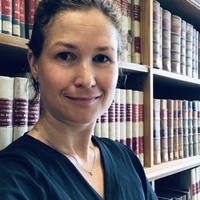

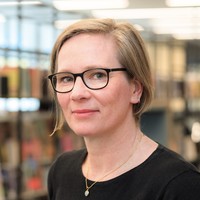






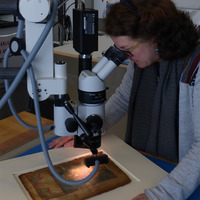
Uploads
Papers by Tjamke Snijders
For a visualisation and brief comparison of the spectral data, see https://www.youtube.com/watch?v=kpD_xtnJdx4
of community in the field of medieval studies. It shows that medieval
scholars have usually proceeded from a ‘strong’ definition of communities,
emphasized geographical boundaries, posited the importance of
consensus, and focused on a common denominator that could be used
to characterize the community. The traditional approach to community
can be contrasted with the concept of a ‘Community of Practice’, which
defines a community as a practice-based social group whose identity is
based on shared performances of a repertoire that is in constant flux. An
implementation of this approach can provide medievalists with the tools
to re-interpret medieval communal identities as multiform and caught
up in a continual process of renegotiation; and what this means for the
way we conceptualize communal learning.
For a visualisation and brief comparison of the spectral data, see https://www.youtube.com/watch?v=kpD_xtnJdx4
of community in the field of medieval studies. It shows that medieval
scholars have usually proceeded from a ‘strong’ definition of communities,
emphasized geographical boundaries, posited the importance of
consensus, and focused on a common denominator that could be used
to characterize the community. The traditional approach to community
can be contrasted with the concept of a ‘Community of Practice’, which
defines a community as a practice-based social group whose identity is
based on shared performances of a repertoire that is in constant flux. An
implementation of this approach can provide medievalists with the tools
to re-interpret medieval communal identities as multiform and caught
up in a continual process of renegotiation; and what this means for the
way we conceptualize communal learning.
Ranging from in-depth case studies to discussions of structure and agency in manuscript terminology and layout in the aftermath of New Philology, this book argues that the High Middle Ages witnessed a fundamental process of manuscript diversification and specialisation, which was at the basis of the thirteenth-century revolution in manuscript layout. This led twelfth-century monks to start conceptualising the manuscript as an object with fixed contents, which was to be used and copied as a whole. Consequently, the production and spread of saints’ lives became part of a process of ideological homogenisation among Benedictine monasteries and started a crucial development in medieval literacy.